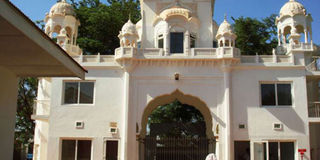Down memory lane on a rainy weekend

The Sikh temple in Makindu which was built in 1926. The temple is now a favoured resting place along the “long, slow and difficult” road. It is a gurdwara, which provides free food and even accommodation for travellers. PHOTO | JOHN FOX
What you need to know:
- You can learn a lot about the history of a place through its names, from Mackinnon, Sclater, Sultan Hamud to Makindu on the long, slow and difficult road to Mombasa.
- But I have taken too long a diversion here. I intended to be writing about Kenyan place names. So let me take Mombasa Road and see what history lessons I can glean from Google.
- The piece gives a link to Gavin Bennett’s Informal History of Motoring in Kenya, which he wrote in 1995. In it, Gavin says that Mackinnon-Sclater Road fell into disuse after the Uganda Railway was built in 1901.
All week it had rained. It looked like it would rain all weekend. “What do Kenyans do when it rains?” I once asked a friend when I first arrived here in the mid-1980s.
“If they can afford to, they stay indoors,” he said.
That’s what I did last weekend.
When, a few months ago, I wrote some articles about street names in Nairobi, Mombasa and Kisumu, I was very surprised at the interest it seemed to stir — judging by the number of emails that came in. So I decided to play another indoor game. I decided to travel with Google.
Where I come from — the East Midlands of England — you can learn a lot about its history through its place names. Town names ending in the suffix “ton” tell you that it was an Anglo-Saxon settlement. I was born in the original Boston, its name being a shortened version of St Botolph’s Town. There are also many towns and villages ending in “by” — names such as Spilsby, Wragby, Grimsby... It’s because this east coast of England suffered rape and pillage and eventual settlement of the Vikings.
Earlier, the Romans, well known for marching and making roads in straight lines, seemed to have avoided a diversion to the east on their way to build Hadrian’s Wall to keep out the Scots. (Yes, Donald Trump might have been inspired by this wall on the way to his flashy Trump International Golf Links in Scotland.)
Anyway, there are no town names in my East Anglia ending in ‘chester’ – like Winchester or Manchester — derived from “caster”, which is Latin for “camp”.
But I have taken too long a diversion here. I intended to be writing about Kenyan place names. So let me take Mombasa Road and see what history lessons I can glean from Google.
40-MINUTE WAR
Ah, yes, I have struck gold straight away. If you, too, look up Mackinnon in Google, as I did to find out what’s behind the name of the township, Mackinnon Road, which is about 100km up from Mombasa, you will see an entry for “Mackinnon-Sclater Road”. This is a piece about the old 1,000km oxcart road from Mombasa to Busia on the border with Uganda.
This was the route started in 1890 by the British East Africa Company — IBEAC. The part of it called “Mackinnon Road”, up to Kibwezi, was built by an Australian called George Wilson, and it was named after Sir William Mackinnon, the founder of IBEAC.
The piece gives a link to Gavin Bennett’s Informal History of Motoring in Kenya, which he wrote in 1995. In it, Gavin says that Mackinnon-Sclater Road fell into disuse after the Uganda Railway was built in 1901.
He says many of the cars later used in the interior were transported there by rail because the road journey from Mombasa was long, slow and difficult. Things haven’t changed much, have they?
By the way, Sclater was Captain Bertram Lutley Sclater of the Royal Engineers, who continued the road from Kibwezi to Busia. And the name Sclaters Road can still be found, I think, in Nairobi.
So that was something about Kenya’s colonial history. A sign of the long Arab influence along the Coast is the town name of Sultan Hamud. Google says little about it, except that it is on the main railway line between Mombasa and Nairobi. Well, it’s also still part of the colonial history, because he was the Sultan of Zanzibar.
Google has a reference to “the shortest war in history” — all 40 minutes of it, when in the August of 1896 one Khalid bin Barghash seized power in Zanzibar in a coup. He ignored an ultimatum to step down, and so the British used their gunboats to set fire to the palace. Khalid fled to German East Africa — now Tanzania. The British then installed their favourite, Hamud, as Sultan.
I have been looking for a town name along Mombasa Road that says something about the strong Indian involvement in building the railway at the turn of the 19th century. Can it be that Makindu is named after a Scot who converted to Hinduism?
Joking apart, Makindu is perhaps best known for its Sikh Temple, which was built in 1926. There were many Sikhs employed on the railway construction, especially as mechanics and train drivers. Some stayed on at Makindu. The temple is now a favoured resting place along the “long, slow and difficult” road. It is a gurdwara, which provides free food and even accommodation for travellers.
All gurdwara places of worship, so Wikipedia tells us, have a langar hall, where people can eat free vegetarian food. I have visited the one in Makindu a few times. It is a pleasant and quite humbling experience.





